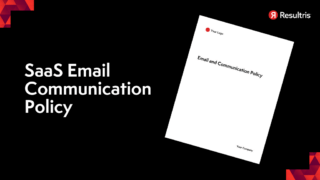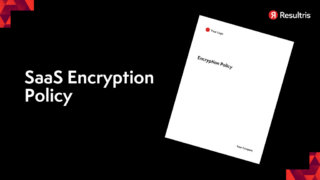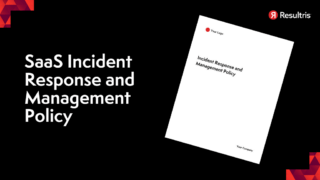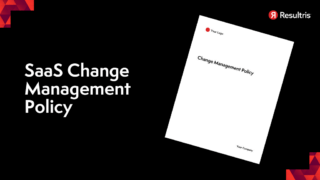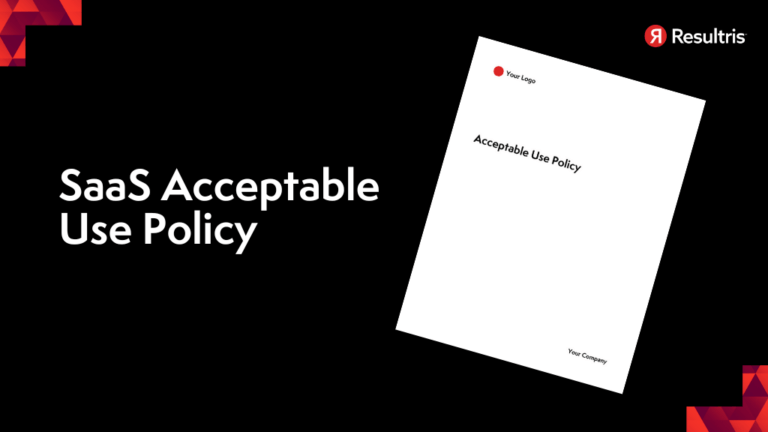
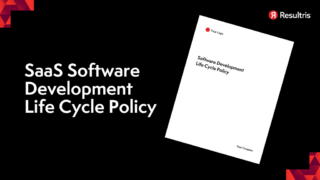
Written by: Tim Eisenhauer
Last updated:

Navigating the maze of SaaS (Software as a Service) can seem daunting, especially when it comes to understanding acceptable use policies. You’re not alone. It’s a complex world where compliance and security are paramount.
Ever wondered how to ensure your business stays on the right side of the law? Or how to protect your data from potential breaches? You’re about to embark on a journey exploring the crux of SaaS Compliance and Security Best Practices.
This article will provide a clear, knowledgeable, and confident guide to the essentials of a SaaS acceptable use policy. So, buckle up and get ready to navigate the intricate landscape of SaaS compliance.
Digging deeper into the world of SaaS compliance, let’s explore what a SaaS Acceptable Use Policy (AUP) really is and why it’s essential for both providers and users alike.
A SaaS Acceptable Use Policy, in simplest terms, sets the ground rules. It comprises a set of regulations stipulated by SaaS providers to guide users on how to use their service responsibly, thus, ensuring ethical and lawful behavior.
From a provider’s perspective, an AUP protects their interests—offering a shield against misuse of their services. For you, the user, this policy provides a roadmap, ensuring you navigate through your chosen SaaS solutions without crossing legal or ethical boundaries.
Ready to dive into the legal jargon? Here’s the lowdown: A robust AUP protects SaaS providers from liability in case of user misconduct. Basically, this indicates that, if a user breaches the policy, the provider isn’t held responsible.
Compliance is a significant aspect attached to AUPs, as they ensure adherence to relevant laws and regulations, domestically and globally. Remember, violation of these regulations can result in severe penalties, both for providers and users. So, being well-versed in your chosen SaaS solution’s AUP can help you dodge those unexpected run-ins with regulations.
A precisely outlined SaaS Acceptable Use Policy establishes concrete guidelines for user behavior. It’s a fine line between providing open access to your services and maintaining a safe, secure user environment. So, let’s delve into the key components that make an effective SaaS Acceptable Use Policy.
Let’s kick off with the activities that are strictly off-limits.
Your SaaS AUP must explicitly detail each and every action regarded as illegal. To avoid legal consequences, it’s crucial to prohibit the use of services for any illicit activities, such as copyright infringement, promotion of illegal substances, or illicit gambling services.
Just like a name that’s tarnished can’t be restored, your Application’s reputation is irreplaceable. Don’t allow any form of harmful, fraudulent, and deceitful behavior. This includes but isn’t confined to spamming, phishing, and identity theft.
Don’t tolerate unauthorized access or attacks on the system, such as DDoS attacks or any form of breach of your security protocols. Your integrity rides on your vigilance.
User responsibilities provide a roadmap to a user-friendly environment.
Each user bears responsibility for the security of their own account, including safeguarding authentication credentials and reporting any suspected account breaches. It’s a shared aisle to walk on, isn’t it?
There should be clear guidelines for user-generated content. This could range from prohibiting offensive content to requiring compliance with intellectual property laws. It’s like telling your users how not to become persona non grata.
Emphasize the importance of not exploiting the system. This means no practices such as data mining, scraping, or overusing resources, negatively affecting the service for others. Sounds fair, right?
Here’s where you assure your users about their data.
Specify what will happen to sensitive information and how it’ll be stored and used. Users should know how their crown jewels are taken care of.
Detail what data you collect, how you collect it, to whom you disclose it, and why. It’s like a clear consignment report with nothing left for guesses.
While every SaaS business is unique, these components provide a concrete starting point for shaping your SaaS Acceptable Use Policy. Remember, it’s your protective shield towards legal huddles and reputational damage.
Creating an Acceptable Use Policy (AUP) for your SaaS platform can require some effort. Address each detail with precision, ensuring that every part of the policy serves a purpose.
Before initiating the AUP development process, conduct a thorough risk assessment of your SaaS platform. Identify possible threats that your software can attract. Examples of threat scenarios include data breaches, misuse of resources, and customer misuse, each calling for a unique mitigation strategy.
Remember to consider rare yet plausible risks. For instance, your platform might attract politically-motivated hackers seeking sensitive data of your users. You could consider incorporating guidelines related to public content moderation as a preemptive measure.
One size doesn’t fit all, especially when it comes to AUPs. Package your policy in a manner that fits your service.
Consider this: if your SaaS solution is a project management tool used by global teams, using H1 terms such as “International Collaboration Code” or “Cross-Cultural Communication Regulations” in your AUP can highlight its relevance.
Avoid generic statements that don’t resonate with your service. Keep references to entities and their relationships specific and relevant.
An AUP should not be a constraint, but a guide for your users. Don’t saddle your software with hard-to-navigate legalese. Use easy-to-understand language and uphold the quality of user experience.
For example, instead of stating, “All users shall maintain a commitment to optimal resource utilization,” phrase it as “Let’s ensure that everyone gets an equal chance to use our resources.”
Laws around data privacy and user security aren’t stagnant. Therefore, involve a legal team to ensure your AUP aligns with existing regulations.
For instance, if you accept European clients, your policy should conform to the General Data Protection Regulation (GDPR). Once the draft seems acceptable, submit it for an official legal review to avoid any legal hassles down the line.
Take the time to craft a detailed and concise SaaS AUP—it’s worth the effort.
Having developed a robust SaaS Acceptable Use Policy (AUP), incorporating it effectively into organizational practices becomes paramount. Addressing detailed processes of policy implementation, from integrating the policy into user agreements, establishing user acknowledgment, and consent procedures, to ensuring policy visibility and accessibility, will be the focus of this section.
You need to integrate your AUP into your service’s user agreements to enhance the legitimacy of the policy and boost its enforceability. An AUP, isolated from other service documents, may not capture users’ attention or get the significance it deserves. Consequently, having it embedded in your user agreements, alongside other mandatory compliance elements, would ensure that users acknowledge and comply with the policy.
For instance, when a Netflix user signs up for the service, they agree to the service’s user agreement, which also includes an AUP. Each element mentioned in the agreement, from copyrights to customer data management specifics, has a link with the AUP to enforce healthy content consumption.
A condition of using any SaaS platform is giving consent to abide by its AUP. So, implementing thorough User Acknowledgment and Consent Procedures is vital. In this process, besides merely presenting your AUP to users, ensure they explicitly agree with all elements of the policy. For a step ahead, consider incorporating a separate section for AUP consent in your onboarding steps.
For example, one common practice is having a clause that users can read and a checkbox declaring, “I have read and agree to the Acceptable Use Policy.” Additionally, users should not have access to your service unless they’ve checked this box.
A transparent policy approach also extends to how visible and easily accessible your AUP is to users. Policies can’t effectively guide your users if they’re not easily available or navigable. So, make sure your AUP is clear and easily located on your platform.
Often, most SaaS platforms place the AUP link at the bottom of every webpage called footer links. They use clear, visible labels like “Acceptable Use Policy” to allow users easy and straightforward access.
Implementing these strategies should help you enshrine your AUP firmly within your service framework—aligning all users with your policy requirements and enforcing safe, ethical, and compliant service use.
As important as crafting an understandable Acceptable Use Policy (AUP) is, enforcing it is equally vital. Through a blend of monitoring, a graduated response system, and an appeal process, you can ensure your AUP is respected, acted upon, and maintains its purpose.
Maintain a watchful stance over your SaaS platforms. Use monitoring systems to detect any signs of policy violation, such as abnormal usage patterns or suspicious data transfers. Robust, intelligent systems can flag potential misuse promptly, aiding in early detection. So, detecting any unauthorized access or inappropriate behavior of users becomes more feasible.
Adopt a step-by-step reaction to policy breaches, catering to the severity and frequency of the offense. This graduated approach streamlines responses to violations and helps curb unwanted actions before they escalate.
Start with warnings, gentle reminders of the policy and the misconduct at hand. Notify users about their policy violation and guide them towards correct behavior. It’s a smart tactic to deter minor violations without resorting to harsher measures.
For repeat offenders or severe violations, account suspension might be necessary. It halts users from causing further harm to your system or to other users and serves as a strong deterrent to others. In extreme cases, account termination becomes unavoidable, eliminating the threat from the system entirely.
When violations cause significant damage or involve criminal activities, legal action becomes necessary. Recourse to legal proceedings can act both as a last-resort solution and a cautionary tale for potential violators.
Establish a fair, transparent appeal process for users accused of policy violations. Give users the chance to explain their actions, possibly correcting false positives from automated monitoring systems. This system keeps your enforcement fair and trusted, quelling user complaints while keeping your system secure.
This section focuses on the technical tools and methods employed in commonly enforcing SaaS Acceptable Use Policy (AUP).
Implanting automated monitoring tools can serve to reinforce your SaaS AUP compliance. These tools identify user activities that breach the policy’s terms, empowering you in maintaining the service integrity. Examples can include software like Site24x7 and ManageEngine, which monitor user actions and generate alerts for potential violations.
Utilize detailed user activity logs and data analysis to ensure AUP compliance. System logs track the activities performed by users, pinpointing unusual or policy-violating behavior. Analysis of these logs, using software like Splunk or Loggly, can reveal patterns, detect violations, and inform about necessary corrective actions.
Alignment of AUP enforcement tools with your existing security systems is crucial. This integration heightens the effectiveness of identifying and addressing AUP violations, fostering a safer and more compliant SaaS environment. Tools like McAfee Enterprise or Symantec offer features for seamless integration, enhancing security mechanisms and the policy enforcement process.
Beyond the adoption and enforcement of SaaS Acceptable Use Policies (AUPs), operational considerations surface as another crucial aspect. Let’s delve into some important facets of this broader scenario.
Untrained employees can undermine your vigilant enforcement efforts. Hence, a comprehensive training program becomes inevitable. Impart knowledge of the essential SaaS AUP principles. Hold regular training and workshops, drilling into the specifics of AUP adherence. Consider simulation-based training, if possible; think realistic scenarios that mimic potential policy violations. Highlighting policy grey areas, addressing doubts, and elucidating violations and consequences – that’s what your training should accomplish.
User queries and complaints pose an additional challenge. However, it’s not just about resolving issues. It’s also an opportunity to educate users about acceptable practices. Develop a responsive and well-prepared support team. Train them not just in resolving issues but also in articulating policy guidelines. Remember, patience and politeness are non-negotiable virtues when it comes to user interactions.
Documentation emerges as your strongest ally when dealing with policy violations. Log all breaches, noting the offender, nature of violation, and the punitive action taken. This data serves several purposes. Firstly, it’s your legal safeguard in case disputes escalate. Secondly, it helps identify recurring offenders or violation patterns. Lastly, it gives you a considerable pool of real-world examples for future employee training or user guidelines. To reiterate, meticulous documentation isn’t bonus points, it’s an essential aspect of your AUP enforcement strategy.
Transparency and communication play a pivotal role in the successful implementation of a SaaS Acceptable Use Policy (AUP). They’re instrumental in informing users about the dos and don’ts while using the service and keeping them updated about any changes.
Complex jargon and legal terms often pepper these policies, making them difficult for users to understand. You, as a service provider, need to simplify these terms, ensuring your users clearly comprehend the policy. Break down complex points into plain language, use illustrations if needed, or even offer a policy summary. This process not only fosters trust but also aids adherence to the policy due to its clarity.
Changes in the digital landscape or business model could necessitate a review and modification of your SaaS AUP. These policy changes need to reach your users effectively to maintain accountability. Send direct emails, put banner notifications on your platform, or use push notifications. Remember, the communication method should ensure all users are promptly and adequately informed of the updates.
Examples serve as benchmarks for the kind of behavior expected from users. Providing specific instances of acceptable and unacceptable use can foster a clearer understanding of the policy. Categorize these examples appropriately under the corresponding terms and conditions, making it easier for users to relate and adhere. Adopt a balance of positive reinforcement (acceptable use) and warning prompts (unacceptable use) to guide user behavior effectively.
Remember, transparency and communication aren’t just about delivering the message – they’re about ensuring the message is understood and applied.
In the realm of SaaS Acceptable Use Policies, legal and ethical concerns lie at the intersection of platform protection and user rights. With various jurisdictions and laws to consider, a clear understanding of these elements is crucial.
While a robust AUP serves to protect your SaaS platform from misuse, it mustn’t infringe on a user’s rights. Striking this balance requires concise policy language, setting out platform use conditions and restrictions. Also, embedding a fair appeal process in your AUP allows for objections on perceived policy violations. When a user violates policies, for instance, their access to the platform could be restricted, ensuring platform integrity.
Though monitoring policy adherence necessitates some level of surveillance, maintaining user privacy is critical. Confidentiality restrictions place a barrier on the scope of monitoring. Thus, it’s vital your users comprehend that while data usage patterns might be monitored, personal content remains off-limits. Only proper privacy policies and disclosure statements can instill this understanding.
SaaS products can reach a global user base. Consequently, various jurisdictions could govern your platform. For instance, a European user would fall under the GDPR, while an American user might be governed by the California Consumer Privacy Act. Comprehending these variances helps ensure that your AUP aligns with applicable laws, thus safeguarding against potential legal complications.
Inherently, managing Acceptable Use Policies (AUPs) in a SaaS environment entails significant challenges. They range from distinguishing vague user behaviors to adapting to evolving online threats and handling the complexity of managing different user types.
A critical challenge to encounter while enforcing AUPs is discerning ambiguous or ‘gray’ areas in user behavior. An activity may not be explicitly forbidden in your AUP, yet it isn’t clearly permitted either. For example, consider a situation where a user frequently downloads vast quantities of data. Is it a case of data hoarding or routine business activity? Making such determinations requires detailed analysis and a good understanding of user patterns. Hence, it’s critical to regularly review your AUP, catering to changes in user behavior and updating clauses as necessary.
The digital landscape changes continuously, with new security threats emerging every day. These threats go beyond mere data breaches to sophisticated attacks like ransomware, phishing, and session hijacking. To stay ahead, your AUP must evolve too. Regular updates that reflect the changing risk landscape and ensure that your policies protect against newer threats are essential. It’s also crucial to educate your users about these threats, and the role following the AUP plays in preventing them.
Another complexity is the presence of different user types, especially in cases where you offer both free and paid versions. Since these user groups have contrasting service expectations, it’s challenging to implement a broad policy that accommodates all. To deal with this, consider developing separate policy provisions or stipulations within the AUP, tailored to the unique needs and demands of each user group. Regular communication and transparency are crucial in conveying these differences and promoting understanding and compliance.
In managing your SaaS Acceptable Use Policies (AUPs), some approaches stand out as particularly effective. They’re precision tactics that can adjust the scales of your organization’s security and legal compliance. Let’s delve into these best practices, shall we?
Routine inspections of your AUPs cannot be overemphasized. Internet regulations, software updates, and ever-evolving cyber threats make static AUPs obsolete. In order to keep your policies relevant, consider regular retrospectives. Review your AUP foundation, assess the connectivity with your SaaS architecture, and update accordingly. A continuous review cycle isn’t just beneficial; it’s critical in the SaaS landscape. The frequency might differ, but in an ideal scenario, consider a bi-annual review. Check authoritative sources such as the Data Protection Commissioner’s guidance for updates and incorporate them as necessary.
Enforceability of AUPs strongly correlates with users’ understanding of these policies. An educative approach tends to work wonders. Equip your users with essential knowledge on cyber threats, internet regulations, and professional ethics through awareness programs. Tailor this training to the needs of your user groups. For instance, admin users, who have more privileges and higher risk exposure, should receive more robust training. A combination of webinars, interactive sessions, and periodic security drills can boost users’ cyber hygiene and subsequently, your AUPs enforcement. Remember, an informed user is primarily your best defense against potential cyber threats.
Find strength in unity. Your battle against cyber threats isn’t solitary. Join forces with your industry peers in establishing mutually beneficial standards. Share insights, exchange best practices, and collectively develop a resilient front against cyberattacks. This collaboration aids in understanding common challenges and developing effective response mechanisms, thereby strengthening your AUPs. Consider joining forums, workshops, and conferences related to SaaS policies, data protection, and cybersecurity.
Expanding on the foundational knowledge established in previous sections, let’s now examine how one can evaluate the efficacy of their SaaS Acceptable Use Policy.
When it comes to a successful SaaS Acceptable Use Policy, numerous Key Performance Indicators lend valuable insights. Metrics such as policy adherence rate, number of policy violation incidents, and frequency of violation recurrence all offer valuable snapshots of policy effectiveness.
Imagine, for instance, you’re examining policy adherence rate. A significant increase in the number of users following protocol signifies the effectiveness of policy implementation. Suppose there’s a decrease – that may suggest an area requiring further attention. Similarly, if the number of violation incidents decreases over time, it reflects positively on the policy’s effectiveness. Repeated violations by the same user signal issues with user awareness or understanding of the policy.
In addition to the general KPIs, User Compliance Metrics help you gauge policy compliance more precisely. These include number of training sessions held, participation rate in these sessions, completion rate of policy acknowledgment forms, and user feedback regarding the policy.
Why these metrics? It’s straightforward. More engagement in training sessions can equate to better understanding of the policy, decreasing the likelihood of violations. Policy acknowledgment completion signifies users have read and understood the policy, while user feedback can highlight areas of the policy potentially needing improvement.
Lastly, consider the impact of your SaaS Acceptable Use Policy on customer trust and satisfaction. This isn’t a numerical metric, but it’s equally vital for measuring policy effectiveness. Happier, trusting customers generally symbolize a well-constructed and effectively implemented policy.
Look at customer feedback and reviews, especially those mentioning your policy. If customers express satisfaction with your policy’s clarity, fairness, and ease of understanding, that’s a win. Conversely, critique concerning these aspects indicates room for improvement.
Remember, a solid SaaS Acceptable Use Policy shapes customer experience and sets the tone for SaaS interactions. By continually measuring its effectiveness, you’re investing in your platform’s security, user satisfaction, and overall business success.
As the digital landscape evolves, so do acceptable use policies (AUPs). Let’s explore some of the emerging trends that are shaping the future of AUPs in the SaaS world.
Artificial Intelligence (AI) and Machine Learning (ML) are becoming increasingly instrumental in enforcing AUPs. AI can instantly detect policy violations, streamline investigations, and automate repetitive tasks. Take AI platforms, for instance. They not only detect infractions but also learn patterns of behavior to predict and prevent future violations. Machine Learning algorithms can analyze vast amounts of data quickly, identifying potential breaches before they occur.
Blockchain technology is another trend making waves in policy management. Its immutable nature offers a level of transparency unmatched by traditional systems. For example, any amends to AUPs made on a blockchain are permanently recorded. It’s absolute transparency. There’s no hiding from policy updates or attempts to dodge new rules.
Since the onset of the COVID-19 pandemic, remote work has surged. As a result, business reliance on SaaS solutions has grown and so has the complexity of managing AUPs. Employees working from home often use personal, potentially unsecured, devices to access SaaS applications. This trend necessitates stricter AUPs to moderate their use and protect business interests. It’s clear that remote work presents new challenges, but with comprehensive AUPs and evolving technologies, businesses can effectively navigate these unchartered waters.
Shared accounts bring unique challenges for Saas AUP enforcement. A shared account means multiple users having access with shared credentials. It amplifies the risk of misuse and creates a hurdle for individual accountability.
To address this, it becomes essential to draft your AUP, keeping team accounts in mind. Remember to clearly outline permissible behaviors, especially regarding safety, data integrity, and feature usage. For example, it might be prudent to prohibit configurations that unnecessarily expose sensitive data.
It’s also wise to invest in SaaS platforms that have robust team management capabilities. For instance, platforms with features that let you assign distinct access levels based on user roles help to minimize the risk and enhance accountability. You’d expect a Marketing Manager and a Data Analyst to have different access privileges, right?
APIs and integrations contribute significantly to the value of SaaS offerings. They allow companies to create custom workflows and improve user experience. But they also introduce potential avenues for misuse. How do you handle this in your AUP?
Firstly, put explicit stipulations regarding API and integration usage. Set clear boundaries on what constitutes “fair use”. For example, you might limit the number of API calls a user can make within a given timeframe to safeguard server resources.
Secondly, require users to comply with the AUPs of the third-party services they integrate. Remember, an integration misused could reflect poorly on your SaaS platform, even if the fault lies elsewhere.
Resellers and white-label providers are allies, expanding your service’s reach. They, however, raise some complex scenarios for your AUP.
For one, resellers and white-label providers might not interact with your product in the same way end-users do. They might have access to functionality that regular users don’t. It’s crucial to anticipate potential issues and address them in your policy.
Additionally, they could pass along your product to end-users who haven’t directly agreed to your AUP. It’s a good practice to require resellers and white-label providers to enforce compliance with your policy with their customers. For instance, you might insist that they include a clause agreeing to your AUP in their own terms of service.
Throughout all these scenarios, it’s important to always remember that the goal of an AUP is to protect your company, your users, and your product’s value. Be firm, but fair, in your expectations, and enlist your users as partners in maintaining a safe, productive digital environment.
Remember, your Acceptable Use Policy is a living document. As SaaS continues to evolve, your AUP must too. Stay vigilant, stay adaptable, and you’ll navigate the complex world of SaaS policy with ease – and integrity.
Striking a balance between security and user freedom in SaaS Acceptable Use Policies presents an exciting challenge. Let’s look at how you navigate it.
SaaS platforms inspire innovation, but reckless exploration can lead to risk. Thus comes the need to mitigate these risks while still encouraging creativity. Implement a sandbox environment, for instance, where users safely experiment without compromising the system’s integrity. Point out the risks but also highlight potential innovation. How do you do this? By clear communication of the policy and even including practical examples for clarity. This way, users understand what they can and cannot do, fostering a safer environment for everyone involved.
Not all users are the same. They have different needs, pose different risks, and thus require varied usage policies. A one-size-fits-all approach isn’t always the best route. Customize policies for different user tiers while preserving security and promoting freedom. A business account user, for example, may require more lenient API usage terms compared to a personal account holder. This flexibility aligns the risks and rewards for each user tier, promoting the best usage scenarios.
Product features dictate the guidelines for acceptable use. A complex SaaS platform with a robust feature set creates an intricate policy. Therefore, each feature must have tailored usage terms to prevent misuse while promoting positive user experiences. Take, for example, a data export feature. The policy should, at a minimum, guide users on appropriate data export practices and clarify consequences of policy breach. This approach ensures that users maximize feature benefits while adhering to the intended purpose.
As your SaaS product gains global traction, spanning jurisdictions becomes inevitable. Different locations often mean different regulations, cultural norms and user expectations. It’s crucial to consider these international nuances in your SaaS Acceptable Use Policy (AUP).
Cultural considerations play a considerable role in crafting globally acceptable policies. Acknowledge the variety of norms, beliefs, and practices that impact internet use patterns across regions. For instance, gender norms in a Middle Eastern country may affect account sharing practices, unlike in a Western country.
Regulatory adherence also becomes complex in an international context. Different countries impose unique rules surrounding data privacy, content moderation, and cyber security. For instances, Europe’s GDPR and California’s CCPA impose strict guidelines on user data privacy and require explicit consent to collect certain kinds of information.
You might find it beneficial to tailor your AUP to align with local cultural and regulatory contexts. Incorporate regional terms, idioms, and regulations in vernacular languages to ensure compliance and user comfort.
Controlling acceptable use across geographical borders brings its own set of challenges. A consistent user experience is crucial for your brand, but absolute homogeneity may be elusive owing to cultural and legal variations.
Imagine attempting to enforce a standard policy regarding hate speech across territories where the definition of hate speech varies. Some countries may have laws criminalizing specific forms of expression that are acceptable in other regions. It’s crucial to address such discrepancies in your AUP.
Moreover, enforcement of AUPs can be tough across borders. For instance, it can be challenging to impose sanctions on a user violating your AUP from a jurisdiction where your actions may not be legally supported. An approach can be to cluster regions with similar cultural and regulatory contexts and enforce region-specific regulations proactively.
Navigating the international landscape in terms of SaaS AUPs is a balancing act. Adapting to cultures and complying with regional laws while maintaining a consistent user experience necessitates a dynamic, flexible, and empathetic approach to policy creation.
Moving forward, let’s dig into the world of crisis management in the context of SaaS acceptable use policy. You know, when things go south, a structured response takes precedence. But how do you shape it? Let’s dissect that.
Facing a large-scale policy violation isn’t just a headache; it’s a potential disaster in waiting. But don’t let it intimidate you. Start by identifying the exact source of violation – it could be a user misstep, a system glitch, or a malicious attack. Always ensure the violation’s source is tracked and exposed swiftly. An example? You’ve got a user repeatedly ignoring forbidden data access protocols. Here, quick action is crucial.
Next, think suspension or temporary lockdown. You might need to limit some functions for particular users or groups during the investigation phase. Like freezing an account suspected of SPAM activity, giving you the space to probe without further violation.
Your last play is a thorough analysis, digging into the causation, scale, and scope. This investigative phase must yield clear insights, nailing down what happened, why, and how to prevent such violations in the future.
Communications, amidst a policy violation crisis, are as important as the technical actions you take. First, craft a reliable incident reporting system. This way, you can swiftly detect potential threats before ballooning into bigger issues. A deployed ticketing system that allows users to report suspicious activities might do the trick.
Prompt and clear communication are your best friend in such scenarios. Disclose what’s necessary – provide regular updates about the incident, making sure no sensitive data is spilled. Try using automated email alerts or dashboards to keep key stakeholders informed. The focus is to be transparent and responsible without causing unwarranted panic – it’s a thin line, but a crucial one.
Once the dust settles, real work begins – policy overhauling. Lessons from policy violation incidents help you plug the loopholes and beef up your SaaS AUPs. First, conduct a comprehensive post-mortem. Look at what went wrong, why it happened, and map out remediation steps.
Revisit your policies, adjusting them to avoid recurrence. You may need to tweak access rights, revise user guidelines, or introduce new security features. Say a user breached sensitive data areas – you could limit their data access, strengthen the login process, or set stricter data handling policies.
Remember, policy adjustments aren’t just reactive; they’re proactive measures that help shield your SaaS platform against future policy violations. So, don’t view incidents as just setbacks, but as essential pointers steering you towards an enhanced, more robust acceptable use policy.
Navigating the complexities of SaaS Acceptable Use Policies isn’t a walk in the park. You’ve seen how these policies play a pivotal role in maintaining compliance, ensuring security, and addressing privacy issues. They’re your safeguard in the digital world, balancing user rights and platform protection. You’ve also discovered how to handle unforeseen crises, from identifying violation sources to implementing temporary lockdowns. Remember, it’s all about structured responses and proactive policy adjustments. The journey doesn’t end here. As SaaS continues to evolve, so too should your AUPs. Keep them flexible, up-to-date, and ready to face the challenges of tomorrow’s digital landscape.
Disclaimer
Please note that the information provided in this blog post is for informational purposes only and does not constitute legal advice. We are not lawyers, and reading this content does not create an attorney-client relationship. For legal advice specific to your situation, please consult with a qualified attorney.

